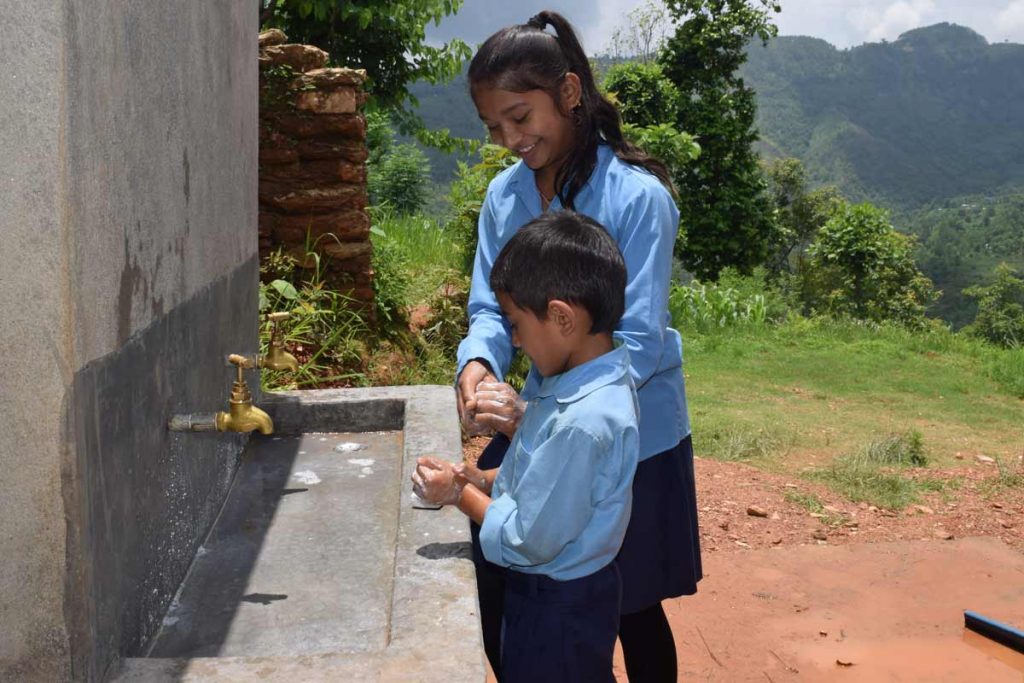Dhading is a beautiful region of Nepal—an explosion of greens during the monsoon season, when the rain buckets down in short, drenching showers that saturate the countryside and fill the area’s streams and rivers. But even though the land is saturated, the people of Dhading lack much of what they need for safe drinking water, including water access points, piping and reservoir tanks, and the knowledge of water management necessary to provide reliable, clean water year-round. Improving this situation will take hard work and a change of attitude and old habits—changes that begin with those who belong to the country’s youngest generation—such as six year-old Aashika Bhattorai and her best friend Anjuta.
The two attend Shree Palpa Samari Bhanjyang School and clasp hands wherever they go. The school, which has over 300 students, is tucked into a hillside in the Muralibhanjyang area, a few hour’s walk from the nearest major town. Aashika’s teachers say that she studies hard at math, language, and history, but it is the newest part of the school’s curriculum that she loves best.
“We’re learning about how to be clean and use water,” she said, sounding both shy and excited.
International Medical Corps, along with a local partner, has brought new water, sanitation, and hygiene facilities and associated learning programs to their school. Most popular with Aashika, Anjuta, and their classmates is the new hand-washing station, which conveniently stands just 27 inches high, a height that offers easy access for all students. Aashika and Anjuta diligently demonstrate how they have learned to wash their hands, not missing a single step of the process. They conduct the demonstration with the grave seriousness that only small children can give to simple things.
“The new hand-washing place is better than the old one,” Aashika said as she reaches for the soap. At the same time Anjuta hums to herself, “We use this one in the morning, before we eat lunch and before we leave school. I like it because it’s my size and the water’s clean.”
Interrupting her own tune, Anjuta explains, “We always use this song to help us remember all six steps,” referring to one of several child-friendly tools used to instill lifelong habits of proper hygiene practices in students.
In addition to providing hand-washing stations and lessons on their use, International Medical Corps is promoting a wider cleanliness and proper water-use campaign, in which student clubs take the lead in creating a hygienically clean, environmentally minded school. Students are learning to manage physical waste by segregating it into bio- and non-biodegradable bins. They are also learning how to manage waste water, using it to care for plants grown in the school’s garden. The produce is then sold to local communities. New latrines have been installed to replace the existing dilapidated, unsanitary facilities, while student clubs help set—and then manage—latrine cleaning schedules and classroom cleanup days. International Medical Corps’ school program is not just about clean hands, it is about a clean environment and lifestyle. The principal of the school has been pleasantly surprised by the change in student attitudes and the eagerness with which they have embraced their new responsibilities.

“The students themselves have taken ownership,” he says. “They’ve become incredibly concerned about hygiene and water use. We have five and six year-olds immediately informing their teachers when soap runs out, and 10 and 12 year-olds eager to arrange cleaning duties. The level of self-management they’ve shown is impressive.”
International Medical Corps’ water and sanitation work in the Muralibhanjyang area of Dhading is not confined to Shree Palpa Samari Bhanjyan School. The earthquakes contaminated and made inaccessible the water sources of the nearby Gairabari community. In response, members of the community located a close by, untapped spring where International Medical Corps has helped build intake and filter systems plus a reservoir storage tank capable of holding up to 6,500 liters on land donated by a member of the community. This new source now provides a direct supply of clean water to over 30 households and nearly 200 people, reducing what was once over an hour-long round trip for residents to obtain water to a short walk.
To ensure long-term access to clean water in the Gairabari community, International Medical Corps has held hygiene promotion sessions, trained community members to maintain water sources, and female health volunteers to make house-to-house water quality checks and provide purification assistance. The project has also revitalized a moribund water user’s committee that collects funds to maintain the water supply and acts as a forum for small landholder farmers to discuss farming systems and crop rotations. With International Medical Corps’ support, the committee also distributes seeds to farmers. The Gairabari community is home to just a handful of the over 100,000 people who benefit from similar International Medical Corps water, sanitation, and hygiene programs in Nepal.
International Medical Corps’ motto is relief to self-reliance. We continue to put that into practice in Muralibhanjyang, in Dhading, and across Nepal by remaining in earthquake-affected communities to help the most vulnerable transition from emergency action to long-term solutions. Our philosophy is not only to restore damaged health systems, but to build them back better. A large part of achieving that is training locals to carry on the work of maintaining a healthy community long after we have left. When little girls like Aashika and Anjuta can take ownership of their own sanitation and hygiene, and can live in a community that guarantees them safe drinking water, we see not only local success, but brighter and healthier futures.
